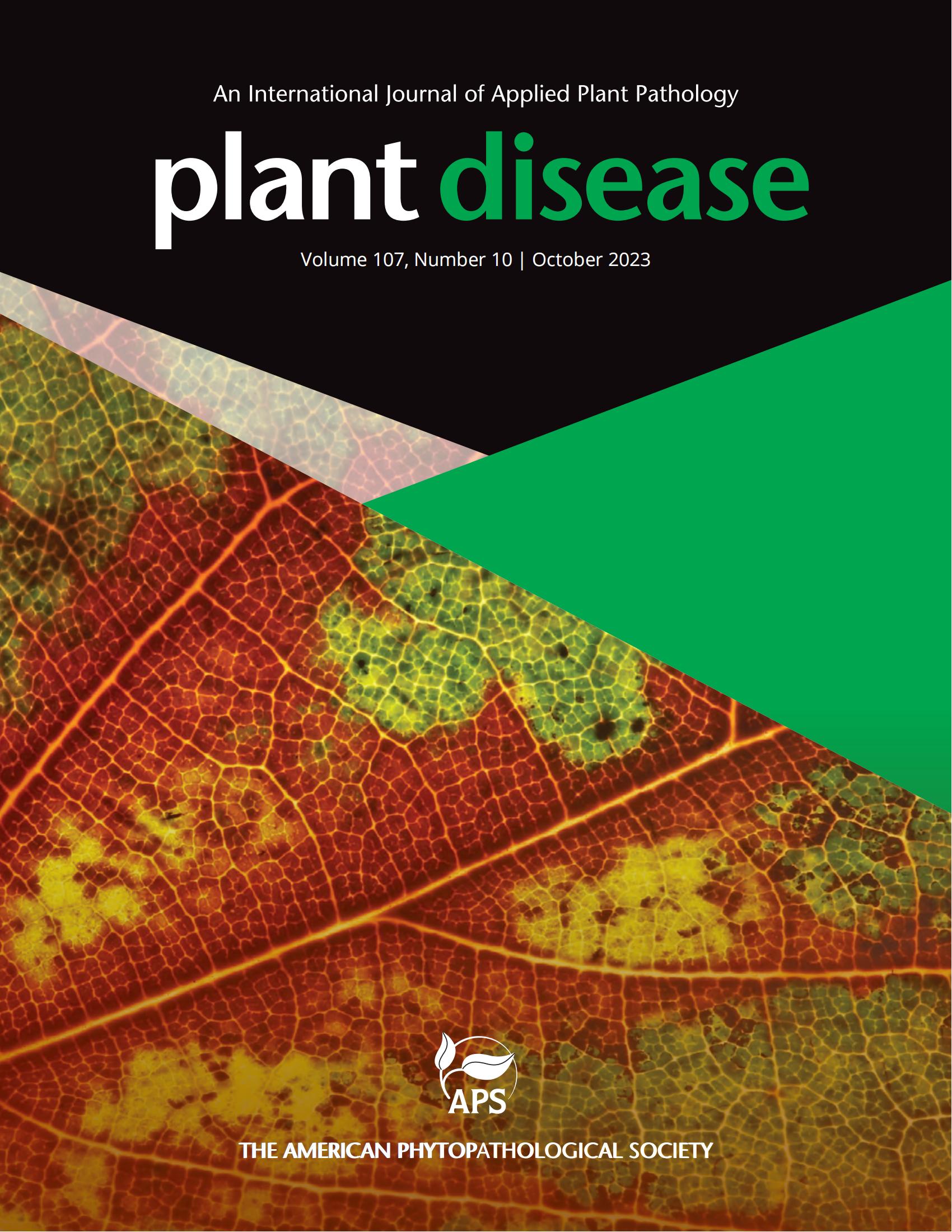首次报告镰刀菌(Fusarium falciforme)在加利福尼亚州引起豇豆(同义,黑眼豆;Vigna unguiculata)根腐病和茎腐病。
摘要
2018 年 4 月和 2019 年 9 月,加利福尼亚州图莱尔县(Tulare County)一块田里的豇豆/豇豆(Vigna unguiculata)都出现了直根腐烂、地下(足部)和地上茎腐烂,有时冠层衰退,影响豆子的形成。在这两块田里,受影响的植株都小于 5%。用 0.1% 吐温 20(浸泡)、70% 乙醇浸泡 30 秒和 1%次氯酸钠浸泡 2 分钟,依次对每块田 5-10 株植物的根脚和茎段(约 1 厘米)进行消毒,然后将其放在含有 0.03% 四环素的 1:10 马铃薯葡萄糖琼脂和镰刀菌选择性培养基上(Leslie 和 Summerell,2006 年)。将镰刀菌样分离物(在分离板中占优势)转移到 0.6% 氯化钾琼脂中,观察到纺锤形弯曲的大锥体和长单胞上假头的各种微锥体,这是茄科镰刀菌复合菌种(FSSC)的特征(Leslie 和 Summerell,2006 年)。分离物 CS221、CS222 和 CS520(代表不同的植物和地点)被保存为单个菌尖培养物。组装了 Illumina 衍生的基因组序列(Burkhardt 等人,2019 年),并从基因组序列中提取了部分 tef1ɑ 和 rpb2 序列(O'Donnell 等人,2022 年)。根据 Fusarium ID 和 Fusarium MLST,这些序列与 F. falciforme 分离物的 tef1ɑ 和 rpb2(tef1a 编号:NRRL 28562 和 NRRL 32331;rpb2 编号:NRRL 22857)的序列有 99.9%-100%的相同性,并保存在 GenBank 中(编号见补充表格)。在温室(13.5-33.6℃;12:12 h L:D)中对三周大的豇豆植株(cv. CB46rk2)进行了致病性评估。在土壤线下约 2 厘米处的直根/茎受伤(宽 1 毫米,深 2 毫米),并用 50 毫升 106 个孢子/毫升的 0.1% 水琼脂或 0.1% 水琼脂(阴性对照)浸泡。试验采用随机完全区组设计,设三个区组,每个区组 2-3 株/分离株,共进行两次。接种后 52 d,83% 接种 F. falciforme 的植株出现地下直根/茎腐病,病斑长度从 25.2 ± 4.2 mm 到 29.2 ± 8.0 mm 不等(P = 0.893(分离株),方差分析)。在试验 1 中,33%-50% 的植株在不同处理下出现树冠衰退(分离株的 P = 0.859),但在试验 2 中没有出现这种情况,这可能是由于试验 2(1 月至 3 月)与试验 1(5 月至 7 月)相比条件更凉爽,压力更小。与阴性对照相比,F. falciforme 分离物对豆类生物量(干重)没有影响(12.5-14.8 克/株;病原体处理的 P = 0.949)。在接种处理中,100%有症状的植株都能从 FSSC 分离物中回收,而阴性对照中却没有(两个试验),所有处理中的代表性分离物均被确认为镰刀菌(tef1a 分析;仅试验 2)。这项研究确定 F. falciforme 是加利福尼亚州豇豆的根腐病和茎腐病病原菌--这种病以前被认为是形态和系统发育上不同的 F. phaseoli(同义 F. solani f. sp. phaseoli)引起的,但缺乏现代病原学研究(Frate 等人,2018 年;Geiser 等人,2021 年)。这项工作与之前关于 F. falciforme 是豇豆(Ajamu 等人,2023 年)和其他豆类(Sousa 等人,2017 年;Duarte 等人,2019 年)根腐病/茎腐病病原体的报道一致。由于镰刀菌也是加州其他作物(包括甜瓜、番茄和开心果)的病原菌,因此明确病原将有助于准确诊断和有效的轮作管理。In both April 2018 and September 2019, cowpeas / black-eyed peas (Vigna unguiculata) in one field in Tulare County, California were observed with tap root rot, both underground (foot) and aboveground stem rot, and in some cases canopy decline, compromising bean formation. In both fields, < 5% of plants appeared affected. Foot and stem segments (~1 cm) of 5-10 plants / field were disinfested sequentially with 0.1% Tween 20 (dip), 70% ethanol for 30 s, and 1% sodium hypochlorite for 2 min and placed on 1:10 potato dextrose agar with 0.03% tetracycline and Fusarium selective medium (Leslie and Summerell 2006). Fusarium-like isolates (dominant in isolation plates) were transferred to 0.6% KCl agar, where fusiform, curved macroconidia and varied microconidia in false heads on elongated monophialides were observed, characteristic of the Fusarium solani species complex (FSSC) (Leslie and Summerell 2006). Isolates CS221, CS222, and CS520 (representing different plants and locations) were saved as single hyphal tip cultures. An Illumina-derived genome sequence was assembled (Burkhardt et al. 2019) and partial tef1ɑ and rpb2 sequences (O'Donnell et al. 2022) were extracted from genome sequences in silico. Sequences were 99.9-100% identical to one another and to deposited F. falciforme isolates based on Fusarium ID and Fusarium MLST for tef1ɑ and rpb2, respectively (tef1a accessions: NRRL 28562 and NRRL 32331; rpb2 accession: NRRL 22857), and were deposited in GenBank (accessions in supplementary table). Pathogenicity was evaluated in three-week-old cowpea plants (cv. CB46rk2) in the greenhouse (13.5-33.6℃; 12:12 h L:D). The tap root / stem was wounded (1 mm wide, 2 mm deep) ~ 2 cm below the soil line and drenched with 50 ml of 106 spores / ml 0.1% water agar or with 0.1% water agar (negative control). The trial was arranged in a Randomized Complete Block Design with three blocks and 2-3 plants / isolate / block, and conducted twice. 52 d post-inoculation, below ground tap root / stem rot developed in 83% of F. falciforme-inoculated plants, with lesion lengths ranging from 25.2 ± 4.2 to 29.2 ± 8.0 mm (P = 0.893 for isolate, ANOVA). Canopy decline developed in 33-50% of plants across treatments in trial 1 (P = 0.859 for isolate) but not in trial 2, likely due to cooler conditions in trial 2 (January-March) vs. trial 1 (May-July), which were less stressful. F. falciforme isolates did not affect bean biomass (dry weight) vs. negative controls (12.5-14.8g / plant; P = 0.949 for pathogen treatment). FSSC isolates were recovered from 100% of symptomatic plants in the inoculated treatments but not in negative controls (both trials) and representative isolates from all treatments were confirmed as F. falciforme (tef1a analysis; trial 2 only). This study establishes F. falciforme as a root and stem rot pathogen of cowpea in California-a disease previously attributed to the morphologically and phylogenetically distinct F. phaseoli (syn. F. solani f. sp. phaseoli), but which lacked modern etiological studies (Frate et al. 2018; Geiser et al. 2021). This work is consistent with previous reports of F. falciforme as a root / stem rot pathogen in cowpea (Ajamu et al. 2023) and other beans (Sousa et al. 2017; Duarte et al. 2019). Clarification of disease etiology will improve accurate diagnosis and effective crop rotation-based management, since F. falciforme is also a pathogen of other California crops including melon, tomato and pistachio.

 求助内容:
求助内容: 应助结果提醒方式:
应助结果提醒方式:


